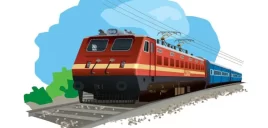Absolute Block’ refers to a system where the the track is considered to consist of a series of sections, such that when one train is occupying a section of track (the block section), no other train is allowed to enter that section. In addition, no train can enter an empty block section without first securing the permission of the station in advance. This is the most widely used system for ordinary train routes.
A station or signalbox controls a block section in one direction (from its rear), and no train may enter that block in that direction without permission from that signalbox (the station or signalbox is said to accept or receive the train). When a train has been accepted, no other trains can be accepted on that block section until it has left that block section.
Obviously the two signalboxes at either end of the block section have to tightly coordinate their actions, especially in the case of block sections that allow bidirectional movement on a single line. The permission to enter the block may be in the form of a physical token carried by the train crew while the train is in the block, or may be implicit in the aspects of signals governing access to the block.
The block section is usually taken to be the section of track from the most advanced signal controlled by the station in the rear (usually the starter or advanced starter signal) , and the rearmost signal controlled by the station ahead (usually the home or outer home signal).
Sometimes a long stretch between two stations may be formed into two or more block sections (intermediate block) to increase track utilization. The same principle applies in receiving a train from one intermediate block section into the next one. The signal controlling entry to an intermediate block section may be operated by staff at one of the stations, or may have a small signalbox (block hut) where the signal is located.
In automatic block territory, however, there may be several block sections between stations; the signals protecting entry to these sections are controlled entirely by the movements of trains on the sections, as detected by track circuits.
The portions of track that lie between the rearmost outer signal controlled by a signalbox of a station to the most advanced starter signal controlled by a signalbox of the same station are said to be within station limits, or to form the station section. Thus, as one goes along the track, one passes from the station limits of one station, through one or more block sections, and then enters the station limits of the next station. The act of admitting a train into station limits is termed reception, and the act of sending it out of the station is termed despatch.
The restriction on more than one train or rake occupying a block section is stringent and can be lifted only in very special circumstances, some shunting operations, for repair and maintenance work, or emergency operations. For instance, a material train may be sent into a block section that already has other departmental vehicles on it. A traffic train may be sent into a section that has an inspection trolley on the tracks. In all such cases, appropriate caution orders are issued to the drivers of the trains involved, and the driver of any vehicle that is proceeding into the block section in contravention of standard block working rules must carry the appropriate authority to proceed.
Within station limits, however, trains may be moved around by the signalman or station master without reference to other stations or signalboxes, and in fact, depending on the rules for station working in effect for the station, shunting operations, calling-on signals, etc. may allow more than one train to occupy a section of track within station limits. There are many stations where two full trains are routinely moved to the same track, to use the same platform (see the trivia section).
Station working rules are determined for each station in consideration of its peculiar track layouts and facilities. Movements within station limits are generally restricted to a lower speed (15km/h) except for through trains on the main running line(s). Analogous to station limits, yard limits are the regions associated with marshalling yards, sheds, etc. where the requirements of shunting or other activity make it desirable to relax the requirements on the number of trains or vehicles occupying a section of track.
Block working, or the method used to implement the block system, can be of several kinds, noted below.
Block instruments (see below for details) control the coordinated movement of trains on the block section; the block instruments of the two stations or signalboxes at either end of the block section are electrically interconnected for this purpose. (Normally a simple audio-frequency modulated code transmitted over trackside or underground wires is used for this purpose; earlier block instruments were connected directly (by DC voltages).) In physical token block areas, the block instrument is also the device that dispenses the tokens, and hence is also known as the token instrument.
Block instruments are quite old. However, in some areas with light traffic, block instruments were not used. Instead, magneto-driven telephone communication was provided between adjacent stations to allow coordination of signals (also known as telephone block.
In areas with track circuits (previous page) block working may be accomplished without block instruments by using the information from the track circuit to coordinate the aspects of signals using electric or electronic circuitry.
In automatic signalling areas, block working is handled by the track circuits connected to the signalling system such that the movement of the trains controls the signals.
Block working can be done with axle counters too. Here, the task of deciding whether a train has entered a section without parting can be automated by counting the axles as they pass the last signal from the dispatching station and comparing with the count of the axles at the home signal of the receiving station. If they match (‘last vehicle proving’) the previous block can be opened for the next train. More often, though, axle counters are used in conjunction with track circuits simply to detect the presence of a train on a section for block working.
Communication between the two signalboxes these days is often by telephone, but in the past telegraph instruments that sounded bell signals were universal, and these are still used a lot today. The bell code used by IR is described below.
IR’s classifies stations according to their role in the block system and their rules for issuing Line Clear indications. See the section on stations for details.
Source – IFRCA.org
This entry was posted in 2 Railway Employee, STUDY NEW, Railway Employee











